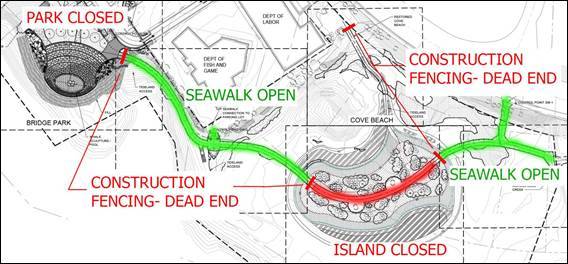On Thursday afternoon, multiple Juneau residents were taking their first trip to the newly-opened Seawalk.
Lifelong Juneauite Terra Peters and her son Troy were walking along the walkway, intrigued to finally take a walk after driving past the construction for the past couple years. Nearby, two workers were installing interpretive signs along the Seawalk, playing classic rock from a portable speaker.
David Price has had a front-row seat for the construction, working for the Department of Labor in its nearby building. He stood in the 60-degree weather on the artificial island in the middle of the Seawalk on Thursday, surrounded by dead trees that were installed to provide landing spots for eagles.
“It’s good for Juneau, I think,” Price said of the project. “Change is good. I’m kind of interested to see where they’re gonna go with the look here. It kind of reminds me of that story, ‘Where the Wild Things Are.’”
The Seawalk, which runs from Gold Creek to Bridge Park next to the Department of Fish &Game building on West Eighth Street, opened this week for the first time. It’s a short-lived opening, however. Either Friday or Monday, the city will close off the island and Bridge Park for further construction.
Contractors will be working in both locations through August, the city announced Thursday. They’ll be planting grass, shrubs and trees on the island, all of which will have an easier time establishing their root systems without people walking around. Heavy construction machinery will occupy Bridge Park as workers continue to build the fountain around the large whale statue.
Portions of the Seawalk will remain open, with access points through the parking lot at the Department of Fish &Game and from the sidewalk on Egan Drive across from Glacier Avenue. Banners that hang above the walkway are designed by Haines Tlingit artist Wayne Price, and other interpretive display various types of plants that will be planted on the island including alkali grass, rock weed and more.
Peters said she appreciated the inclusion of artwork on the Seawalk.
“Just having a nice public space where people can gather,” Peters said of what she liked most about the Seawalk. “It’s artistic and it opens up the waterfront for us, which wasn’t as accessible as it is now.”
‘Unknown’ timeline
The construction of the section from Bridge Park to Gold Creek — which is entering its third and final phase — is projected to cost $10 million. It’s funded by marine passenger fees (a tax that the city charges cruise ship visitors) and City and Borough of Juneau sales tax revenue. The Whale Project donated the whale statue and an additional $615,000 for the pool and fountain, Project Manager Skye Stekoll said. CBJ contributed the property for the project.
Eventually, the goal is to have a 1.8-mile path from Bridge Park to the rock dump. Stekoll said it’s hard to predict just how long the whole project will take to complete.
“The remaining areas of the Seawalk all require negotiations with private property owners,” Stekoll said via email. “That’s how we’ve decided which phase of the Seawalk to construct next — when a deal is worked out with the private property owners. So, the timeline is unknown. We are actively working on all remaining areas but nothing is imminent at the moment.”
This goal was set in the Long Range Waterfront Plan adopted by the CBJ Assembly in 2004. The plan said the Seawalk aims to “serve as the defining linkage connecting all activities along the waterfront” for both locals and tourists.
There is a question as to how much use those tourists will get out of the Seawalk, which has led to the Cruise Lines International Association (CLIA) suing the city. In April 2016, CLIA filed a lawsuit against the city asserting that the city misused marine passenger fees by using them on the Seawalk and Bridge Park.
In CLIA’s view, these funds should have been used for something more directly related to the cruise ships and passengers. City officials argue that cruise passengers will use the Seawalk and the see the whale sculpture, so the use of the funds is appropriate. As of February, the city had already spent $283,000 on the lawsuit and set aside $100,000 more in next year’s budget to pay for outside counsel.
Price, who has lived in Juneau on and off for 40 years, believes the passenger fees should be spent on something that benefits both the passengers and the locals.
“It’s part of the price they pay for coming here,” Price said. “That funding is to go into the community. They get to come and go and we get to live here and stay here the rest of the year. It’s giving something back to the community that we get to see all year round when the tourists aren’t here. I think it’s a good thing.”
An earlier version of this article stated that Haines artist Wayne Price designed the interpretive signs along the walkway. He designed the banners that hang above the walkway.
• Contact reporter Alex McCarthy at alex.mccarthy@juneauempire.com.

